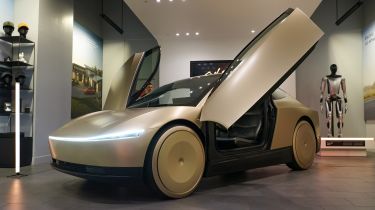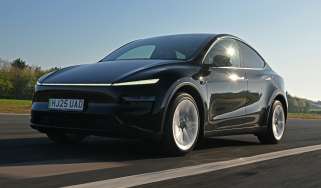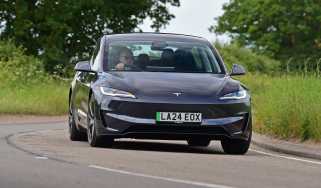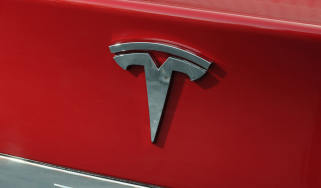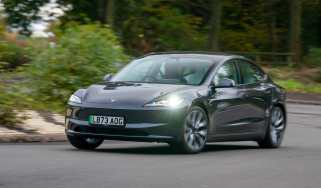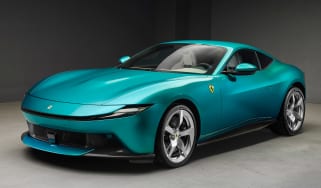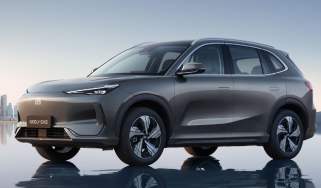New Tesla Cybercab preview: 300-mile range for self-driving robotaxi due in 2027
Tesla’s Cybercab will be two-seater with no steering wheel and a relatively small 50kWh battery
Fully autonomous cars are closer than ever to becoming a reality here in the UK. The technology is rolling out in other countries already and Tesla has established itself as a pioneer in the space. Elon Musk’s EV brand has just revealed some new details regarding the futuristic Tesla Cybercab, which it hopes will bring self-driving cars a step closer.
In a recent interview with YouTube star, Sandy Munro, Tesla’s Vice President Lars Moravy, revealed that the American firm is looking to power the Cybercab with a battery pack smaller than 50 kWh, but is still looking to target a “real-world” range of around 300 miles. To put that rather impressive battery size to range ratio into perspective, the base Tesla Model 3 with its 60kWh battery can cover 318 miles on a charge and the MG4 with a 49kWh battery will cover 218 miles of range.
Initially revealed last year along with the 20-seater Tesla Robovan, the Tesla Cybercab is set to launch in 2027. We’ve already had a poke around the Cybercab in person at London’s Westfield Shopping Centre back in late 2024. Tesla describes the Cybercab as “premium, point-to-point electric transport, accessible to everyone”. Both the Cybercab and Robovan feature full self-driving (FSD) technology, and as a result, there’s no steering wheel or pedals for a driver.
| Key specs | |
| Fuel type | Electric |
| Body style | Coupe, two-seater |
| Powertrain | Battery, electric motor |
| Price | £23,000 (est) |
What powertrain and charging details can we expect?
While range and battery figures have now been suggested, Tesla and CEO Elon Musk have stayed tight-lipped about the rest of the Cybercab’s technical details. The brand has claimed the Cybercab will achieve a minimum efficiency figure of around 5.5 miles per kWh. For context, most EVs today return between three to four mi/kWh during our own testing.
Inductive charging will be a standout technological feature of the Cybercab. Musk said “it was high-time” Tesla introduced this technology to its cars, and it means the Cybercab won’t come with a socket to charge up. Instead it will drive onto a charging pad and recharge wirelessly.
There was no charging port or flap visible on the prototype we got to have a look around, so we don’t expect the Cybercab to come with the ability to make use of Tesla’s Supercharger network, which currently includes more than 1,600 ultra-rapid charging points across the UK.
Given the priority of range over performance and dynamism for the Cybercab, we expect it to come only with a single-motor powertrain. Under the almost coupe-like body, the Cybercab is probably using the platform that would have underpinned the £25k Model 2 that was scrapped in favour of autonomous vehicles.
As for the body, Tesla has said the Cybercab will use a casting process with two separate pieces for the front and the rear with door castings to connect them. The idea is to lower production costs as much as possible and reduce complexity with no paint needed for casting metals.
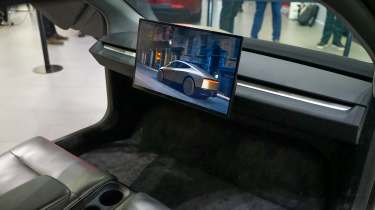
What is the exterior and interior design like?
Tesla is known for its minimalist interiors, but the Cybercab takes things to a whole new level. As we mentioned, there’s no steering wheel or pedals, just a 20.5-inch screen for controlling the car’s functions, two seats, two cup-holders and an armrest. The all-black colour scheme is in stark contrast to the lighter, more airy design of the Verne robotaxi’s interior.
At the back is a large boot with a hatchback-like tailgate. Tesla hasn’t provided an exact luggage capacity yet, but says the boot will be big enough for two carry-on suitcases and another two pieces of hand luggage. We’re also told you can fit a bicycle in the boot of the Cybercab.
The exterior of the Cybercab is also pretty minimalistic, with smooth, simple surfacing, full-width light bars at the front and rear, plus no back window or side mirrors. The Tesla also has a set of butterfly-style doors, and instead of a traditional alloy wheel design, it boasts blanked-off wheel discs with larger rear rims compared with the fronts. However, it’s not clear how many of these features on the prototype will make it to the production car.
What is the law on self-driving cars in the UK?
Full self-driving cars got a boost earlier this year when the UK government passed a bill called the Automated Vehicles Act. It essentially enables the introduction of fully autonomous vehicles to UK roads within the next couple of years – provided they “achieve a level of safety at least as high as careful and competent human drivers”.
Highlighting the Cybercab’s self-driving capability is the lack of a steering wheel inside. That could prove to be tricky for the car here in the UK, because the Automated Vehicles Act requires a person to give inputs to the car on occasion.
Many billions of pounds have been spent on autonomous vehicles by a wide array of manufacturers, but so far, due to legislation, we’ve yet to see a full self-driving car on UK roads. The technology is here, however. Most autonomous prototypes have been based on existing cars, such as Jaguar and Waymo’s I-Pace-derived creation back in 2018, and Hyundai’s Ioniq 5 test car being equipped with Level 4 technology.
The Tesla Cybercab’s most direct competitor is another two-seat robotaxi from Croatian start-up Verne, which was created by Mate Rimac of electric hypercar fame. The car is confirmed to be hitting the streets of Manchester in the UK within the next few years.
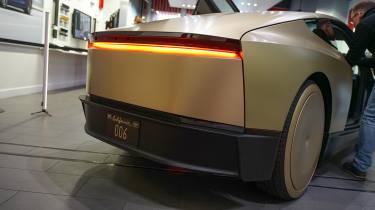
What will the Tesla Cybercab’s price be?
During the reveal of the car at Tesla’s ‘We, Robot’ event in California in 2024, CEO Elon Musk said “we expect it to be around $30,000”. That would make the Cybercab roughly £23,000 in the UK, although, as we’ve said, there are no firm plans to bring the Cybercab over here.
However, that’s not surprising, because Musk himself admitted during the same event that he tends to be “a little optimistic with timeframes,” and so far has only said that the Cybercar is expected to enter production “before 2027”.
In those locations where the Cybercab does launch, we’re told the car will be accessible to anyone via the Tesla app, and will be yours for as long as you need it – even a whole day if necessary.
Now you can buy a car through our network of top dealers around the UK. Search for the latest deals…
Find a car with the experts

